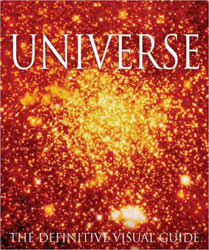
Big topics need big books. You can’t get a much bigger topic than the universe, and the book edited by Martin Rees entitled Universe – The Definitive Visual Guide fits the bill for size. This is a large book in dimensions and content. It covers most of the interesting lore in cosmology and astronomy and is chock full of pictures, explanations and trivia of astronomical history. Big is the order of the day and big appetites will be well satiated after reading this.
The universe is the be all and end all. Having a visual reference doesn’t come easy for such a scope, especially when much lies outside our eye’s realm. The universe is all of space and all of time. It is all of matter and all of energy. Our eyes can detect some of the matter and energy on Earth. But, we don’t see quarks or super galaxy cluster filaments. Yet we know they exist. We also can’t see the opaque universe at the beginning of time or the appearance of the universe after its deep freeze. Yet we believe that these also have a place in our existence. Hence, with imagination and the power of knowledge, we can represent images and concepts on flat pieces of paper to visualize the entire universe.
This book is billed as a definitive visual guide. As such, readers get exciting descriptive answers to almost every relevant astronomical question. The book has three main sections. The introduction establishes the physical basis for the universe; its size, its matter, its inter-relations. This continues with descriptions on man’s interactions, from choosing binoculars to describing the space race. Following this extensive and in-depth introduction is a section on the material objects. There are planets, stars, galaxies and all the rest that amateur and professional astronomers have detected and mapped. The last section provides the standard information on night sky viewing. All 88 constellations and monthly night sky charts fill the pages in wonderful detail. This one-stop book is an excellent reference for space related visual images.
Calling a book a definitive visual guide is risky. Often books with this title quickly find themselves in the sell-off bin of the store as they contain little more than stock footage. There is lots of stock footage in this book, but principally because there is only one main source, NASA. Nevertheless, this isn’t a constraint, as many other sources like the Galaxy Picture Library and the Anglo Australian Observatory contribute. Further, this book doesn’t showcase any source. Images are woven throughout the text to glorify the subject matter rather than the group or machine behind the camera shutter. With judicious editing, it is not the source that sparkles but the subject of the pictures.
As much as Martin Rees is billed as the general editor, there is obviously more here than one person could conveniently accomplish. In all, the book lists 19 editors with many others contributing. With so many cooks, there is the concern that the broth may spoil. Not in this case. There is little duplication. The hundreds of pages and multitude of topics blend into each other in harmony. The section describing the planets is particularly nice, as some of the most recent images from the Huygens probe and the Mars explorers grace the pages. Each page spread itself is 30 by 50 cm, hence allowing for majestic sweeps of other worlds. Dominant features of every photographed planet and many moons are described as if for a travelogue. Chasms, canals, peaks and striations are named, located and graced with a sense of shape and importance. This same attention to detail extends in the following section to stars, nebula, supernova and black holes. Most alluring of all though is the preponderance of choice images. After all, this book is called a definitive visual guide.
Being big with lots of pictures, however, doesn’t always make for a stimulating book. This visual guide is no different. It is dry like an encyclopaedia. You won’t sit for hours in your favourite reading chair. It is both too heavy to hold comfortably and too staid. There is no plot to capture the imagination. Like a reference, it simply states particulars then heads off to the next topic. Understandably, the universe is so big there is little opportunity to diverge. In any case, the pages are very well appointed, not too busy nor too sparse. The topics are current and with enough depth to satisfy the generalist. It is an excellent reference source for the backyard astronomer preparing for their evening viewing. Or, it can provide a rich background for young researchers.
Our universe, from an astronomer’s perspective, is a wonderful, visual cornucopia. The book Universe – The Definitive Visual Guide edited by Martin Rees aims to satisfy the appetites for those branching into this domain. This big book does justice to the largess of the universe.
Review by Mark Mortimer
